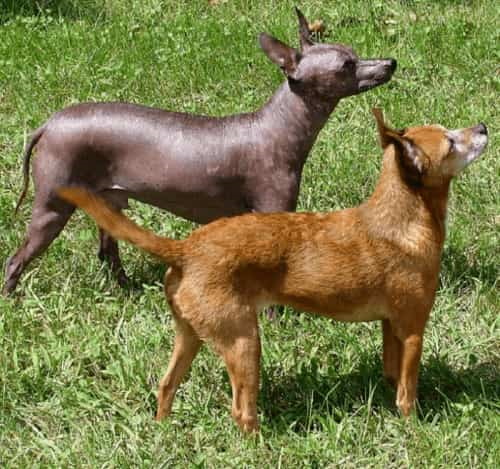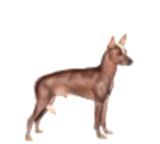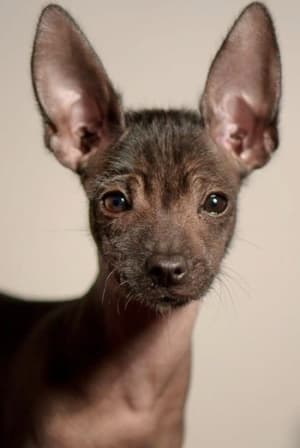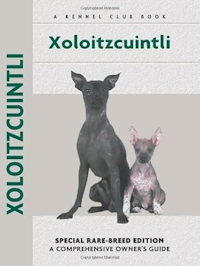Xoloitzcuintle - Rare Dog Breed
Xoloitzcuintle (also spelled xoloitzcuintli), is a hairless and very rare dog breed that is thought to have originated in Asia or Africa and ultimately brought to South American by traders.
Most often this dog breed's name is shortened to Xolo for obvious reasons - but if you want to know how to pronounce its full name, it is show-low-ee-squint-lee. The name is derived from the Aztec god Xoloti. In Mexico they are popularly known as Itzcuintles.
 Michael and Misty by C.A. and A.L. Dellario
Michael and Misty by C.A. and A.L. DellarioMany of those familiar with this ancient breed also refer to it as the Mexican Hairless dog. This
name variation no doubt came about due to its long association with the Aztec culture.
With roots dating back 3000 years, it is
thought that the Aztec Indians acquired the Xolos after they were brought to South America
by traders and called them Biche - which translated means naked.
Archeological explorers in
the Aztec regions have unearthed many very old pottery-type artifacts depicting this rare dog
breed, as well as their actual remains found in ancient tombs.
These discoveries attest to the Aztecs belief that the Xolos had spiritual powers and could guide the human spirit to
the after world.
Despite the fact that the Xolos are hairless, they have also been used on cold nights for
warmth. Many also claim that this dog breed has curative abilities, especially in alleviating
aches and pains of the joints.
In fact, the Aztecs are known to have eaten their meat as a
regular source of protein and for their belief in its healing powers, as well as to have
sacrificed them in spiritual ceremonies.
Appearance of the Xolo
The appearance of the Xoloitzcuintle is not unlike the Chihuahua with respect to facial and body type features. It has smooth
tough skin and very pronounced upright large ears.
It keeps its coat oiled from glands found between the toes. Occasionally a dog will have a shock of hair on
top of their head and a small percentage will be born with a thick coat of hair.
At one point during
the 40's this rare dog breed was in danger of extinction, but interested fanciers came to
the rescue and began developing a larger gene pool through the second half of this century.
Current breeders are very motivated to keep an interest in the breed and do whatever they
can to increase their popularity.
Physical Stats of the Xoloitzcuintle

There are three sizes of the Xoloitzcuintle breed:
miniature, medium and standard - the biggest variety being about the size of a Lab and the
smallest about 3 inches taller than a Chihuahua.
Height: 13 to 22.5 inches
Weight: 10 to 50 pounds
Coat colors: All are solid and include charcoal, liver or bronze, slate, and dark reddish grey.
Group: Non-Sporting
Coat and Grooming Care
One of the main features of the Xolo that attracts many owners is its smooth hairless coat,
although there is a coated variety.
Those with allergy problems often find the hairless variety with its overall cleanliness and lack of parasites, enables them to own a pet.
The skin of the Xoloitzcuintle, though quite hardy, does require
occasional brushing and the use of more gentle grooming products such as
shampoo and sunscreen,
so as not to strip the natural protective oils from the skin. For the
same reason, frequent bathing is not recommended.
Basic care includes brushing teeth several times a week, clipping nails
cleaning the ears as needed. Inspect the coat and wipe off any debris
with a dampened shammy.
On more intensely sunny days, the skin can use the added protection of a
light coat. Likewise on colder days, a sweater or coat is needed for
warmth.
Characteristics of the Xolo Dog
Owners report that the Xolo is very affectionate, sensitive and loving and makes a devoted
family pet.
Behavior-wise, this breed is considered quite feisty and does a good job as a
watchdog, but is not an indiscriminate barker. He is cautious and protective around
unfamiliar visitors to the home.
The Xolo is considered to be of a high intelligence level that is easily trained, but
does best with owners who can assume the alpha role and be consistent.
Xoloitzcuintles are generally a very healthy breed and quite robust dogs with a potential life
span of 12 to 15 years. If you are interested in acquiring a Xolo, try to find a breeder whose
primary goal is to continue the healthy attributes of the breed and keep the health profile
of this rare dog breed on solid ground.
The Xoloitzcuintli dog breed is enjoying a significant
rise in popularity as more people become familiar with them. They have once more become
prized and interesting companion dogs for many of their attributes.
 Young Xolo Courtesy of "Weexolo"
Young Xolo Courtesy of "Weexolo"
Health of the Breed
While the Xolo has an overall healthy profile, the main issues that may affect the breed include:
- Hip dysplasia,
- Luxating patella (slipped knee cap),
- Eye conditions.
The national breed club does recommend that breeders conduct health exams on parents of projected litters.
The recommended exams/tests
should include cardiac health, evaluation of the eyes, and evaluation of
hips and patellas.Those interested in acquiring a puppy should expect to see the test results.
With adequate exercise, high quality nutrition, and regular veterinary check-ups, pet parents can enjoy their Xolo for up to 15 years.
How Active is the Xolo?
The Xoloitzcuintle enjoys exercise, likes to play, is quite athletic and does well in agility trials.
Owners can easily handle their exercise needs with a daily long walk or jog once they are
beyond the exuberance of puppyhood and have physically matured.
Ideal Living Space
This breed prefers to live inside and be involved with the family.
They are adaptable to any type of accommodations be it a house, condo or apartment, but an enclosed outside area is
the ideal for necessary breaks, training and play.
Is This A Good Breed For Children?
This breed does best with young children after the Xolo has been well-socialized.
That being said, older children who are considerate and sensitive to pets would probably enjoy this unique and special dog.
Always have an adult monitor interactions between children and pets.
Seniors or Less Active Families?
The Xoloitzcuintle bonds closely with its owners and is very loving. However,
they do require a daily walk and more exercise during their first year of life.
If this can be handled, anyone would enjoy this very smart dog.
In addition, they are highly valued as therapy dogs and companions to the elderly.
Before You Go...
If you like the content of this page, as well as others on my site, please give it some love by clicking on the heart in the lower right hand corner. This helps me keep providing enjoyable and useful content.
Thank you.
Fun Stuff for Small dogs
Xoloitzcuintle images:
Michael and Misty, hairless and coated Xoloitzcuintlis. by C.A. and A.L. Dellario
https://commons.wikimedia.org/wiki/File:Hairless_and_coated_half.JPG
http://creativecommons.org/licenses/by-sa/3.0/, via Wikimedia Commons
Young Xolo by Author Weexolo
https://commons.wikimedia.org/wiki/File:Youngtoyxolo.jpg https://creativecommons.org/licenses/by-sa/3.0, via Wikimedia Commons

